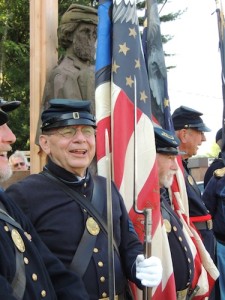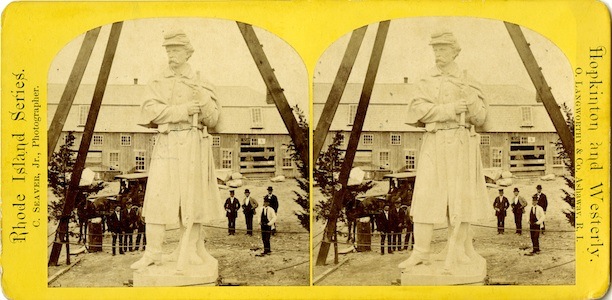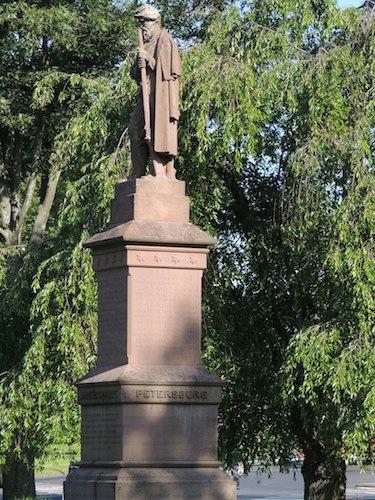By Anthony Roy
By the time the Civil War ended, with the sort of carnage that no one ever imagined, the need for remembrance became paramount. With some 750,000 people killed in a matter of just four years, monuments became one way to honor self-sacrifice and duty to the nation. Private and public money funded tributes all over the state and the nation. A great sense of nationalism accompanied the dedication of these memorials. This was the sense of pomp and circumstance that accompanied the completion of many of James G. Batterson’s monuments, but the old brownstone soldier, most commonly referred to today as the Forlorn Soldier, never received such accolades. The contrast becomes apparent when looking at the dedication of similar monuments throughout Connecticut.
There was a large attendance in Granby on the Fourth of citizens of that and the surrounding towns, the occasion being the dedication of the Soldiers’ Monument. . . . The exercises on the “Green” were in accordance with the following order of exercises:–A National Salute will be fired at 12 m.; Dirge by the band; Dedicatory Prayer . . .;Dedicatory Hymn, written for the occasion, to be sung by the audience; Star Spangled Banner by the band.
– “The Fourth of July at Granby: Dedication of the Soldier’s Monument,” Hartford Daily Courant, July 6, 1868.
The soldiers that died were honored not only by the presence of the people in attendance and the ceremony dedicating the Soldiers’ Monument, but also with their names and the major battles where they fought etched into the monument itself. Organizers commemorated both white and “colored” soldiers from town. A local news reporter urged others to follow in the footsteps of the towns that commemorated their lost brethren to the ravages of the Civil War: “The citizens of Granby do honor to themselves as well as to their dead brothers by this work. In this county Bristol and East Hartford have already done their duty in this matter and it is greatly to be desired that every town in the state that has lost soldiers in the war shall do likewise. The thought that this would be done lightened the dying hours of many a brave soldier.”
Monument Dedications Throughout the State
Many people throughout the state displayed this same sentiment and dedicated monuments with much fanfare. In New Haven, the State of Connecticut erected a “beautiful tribute to our dead soldiers and an honor to the State,” when they called upon Batterson to commemorate those that died in the Knight Hospital in that city. In Meriden, the fanfare proved extraordinary. Two days prior to the dedication ceremony, the Hartford Daily Courant ran a story promoting the elaborate events and the expected attendance of a large number of ex-soldiers, the commander of the department of the Connecticut Grand Army of the Republic, nearly all of the posts of the state, several bands of music, and General Joseph R. Hawley. In addition, a call went out to all men who fought from Meriden to join the procession: “All ex-soldiers from this city who desire to join in the procession are requested to appear in dark clothes, fatigue cap and white gloves, and report at the depot to Major B. F. Blakeslee, commander of the Stedman Post, who will provide them with the appropriate badge and position in the line of march.”
When officials dedicated the monument two days later, the public received it with as much pomp and circumstance as the news reports predicted. There was a parade, bands of music, and speeches from Joseph Hawley and William Buckingham, Connecticut’s governor during the war. As described in a Hartford Courant article, the town basically shut down so people could attend the event: “The soldiers’ monument was dedicated Wednesday, almost all of our citizens participating. The day was a general holiday, and the houses and stores in town were handsomely decorated. . . . After a fine parade through the principal streets the procession drew up in the square west of city hall, where the monument is situated. This is a beautiful work, costing $9,500, and will prove a permanent ornament to the city.”
The Batterson monument that probably received the most fanfare was the colossal soldier statue created to honor some 23,000 soldiers that died during the 12-hour battle in Sharpsburg, Maryland. The stone soldier itself consists of two pieces crafted together, stands at 21 ½ feet tall, and weighs approximately 30 tons. Once mounted on its pedestal, the shrine stands at 44 feet, 7 inches. Local media pronounced the unveiling of the statue before “A Gala Day in Westerly”—where the monument was crafted.
A large concourse of people numbering some four thousand assembled today at Batterson’s quarries to witness the unveiling of the colossal soldier for the Antietam monument. Permission having been obtained from Commissioner McNary of Hartford to have the unveiling a part of the exercises attending Decoration Day, the military companies, fire department, temperance organizations, bands of music, members of legislature, town officers and private persons formed a procession of several hundred and marched to Quarry hill, which overlooks the beautiful village of Westerly. The ceremonies were very interesting, and amid the cheers of the thousands gathered the veil dropped at the feet of the great granite soldier, and at the same time the American flag was waved over the statue.
– “A GALA DAY IN WESTERLY. Unveiling of the Colossal Soldier for the Antietam Monument,”
Hartford Daily Courant, May 30, 1874.
Crowds celebrated the Antietam monument, most commonly referred to today as “Old Simon,” again during its unveiling at the Centennial Exposition in Philadelphia in 1876. Crowds gathered once more in 1880 when the structure reached its final resting place in the Antietam National Battlefield in Sharpsburg, Maryland.
The Forlorn Soldier, however, languished for over a century with no such honors or dedication. In fact, the first known news article discussing the old brownstone soldier marked the statue as an outcast: “Because he got Hayfoot mixed with strawfoot, the enlistment officer wouldn’t have him in his army . . . the winds and the rain, to say nothing of two full generations of small boys . . . have taken his musket and the hands that held it, part of his face . . . disarmed and ragged . . . he still stands, faithful to duty, recognized by no one else.”

The relocation of the Forlorn Soldier to the Connecticut State Capitol, July 19, 2013 – Courtesy of Anthony Roy
The Forlorn Soldier’s sordid story sustained until the Connecticut Civil War Commemoration Commission took up the task to relocate the Civil War relic to the Connecticut State Capitol. The first of the commemorative events for the Forlorn Soldier took place on July 19, 2013. About 100 people attended and, in similar fashion to dedications that occurred 150 years prior, there were speeches, songs, and military displays to commemorate the soldiers that gave their lives in the Civil War.
Anthony Roy is a regional historian and social studies teacher at Connecticut River Academy whose work related to the Forlorn Soldier was completed as a part of his candidacy for a master’s in public history from Central Connecticut State University and as a part of the Connecticut Civil War Commemoration Commission’s efforts to study and inspire awareness of the American Civil War and Connecticut’s involvement in it.
<< Previous – Home – Next >>












